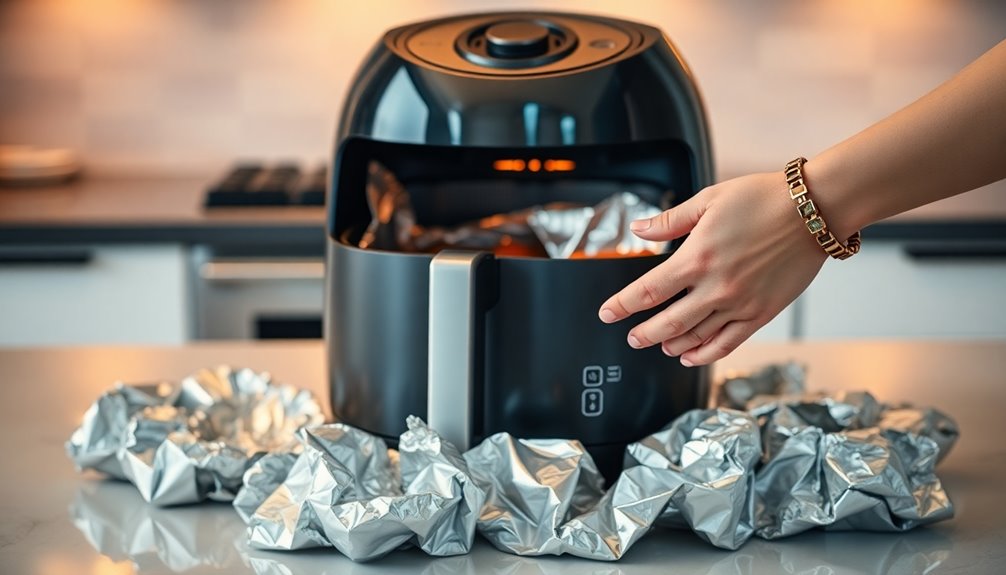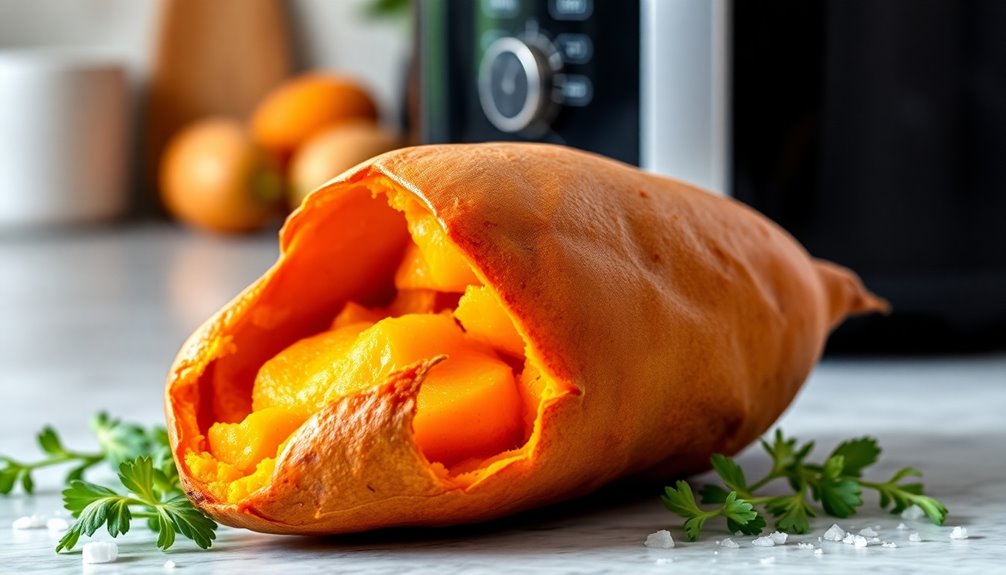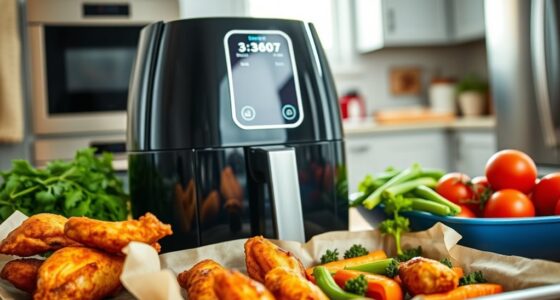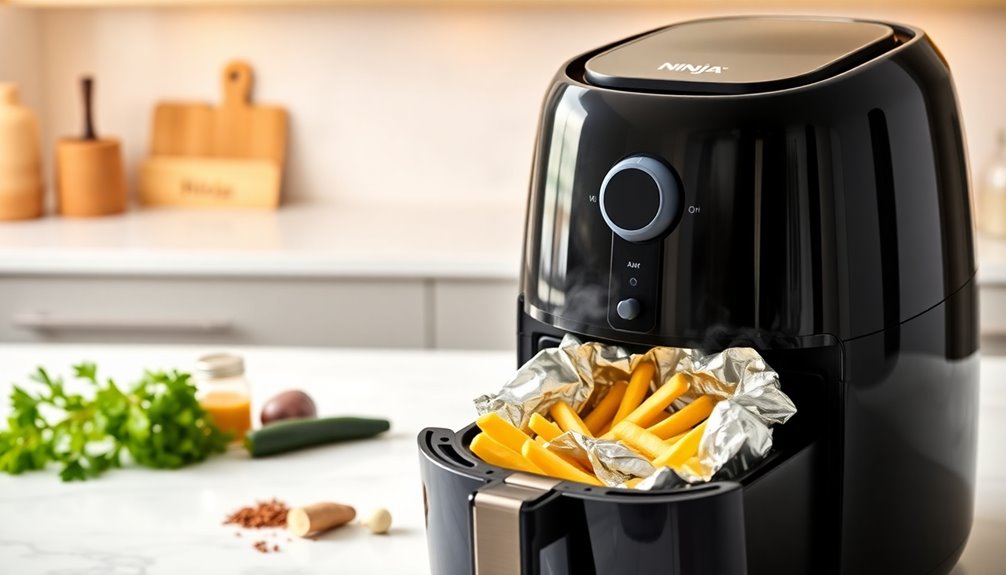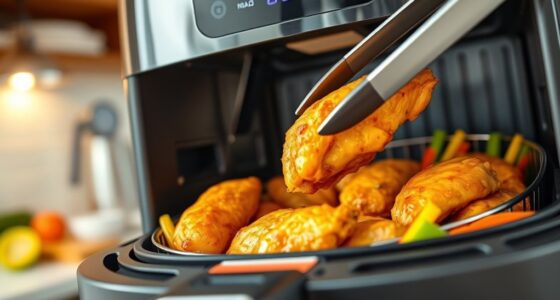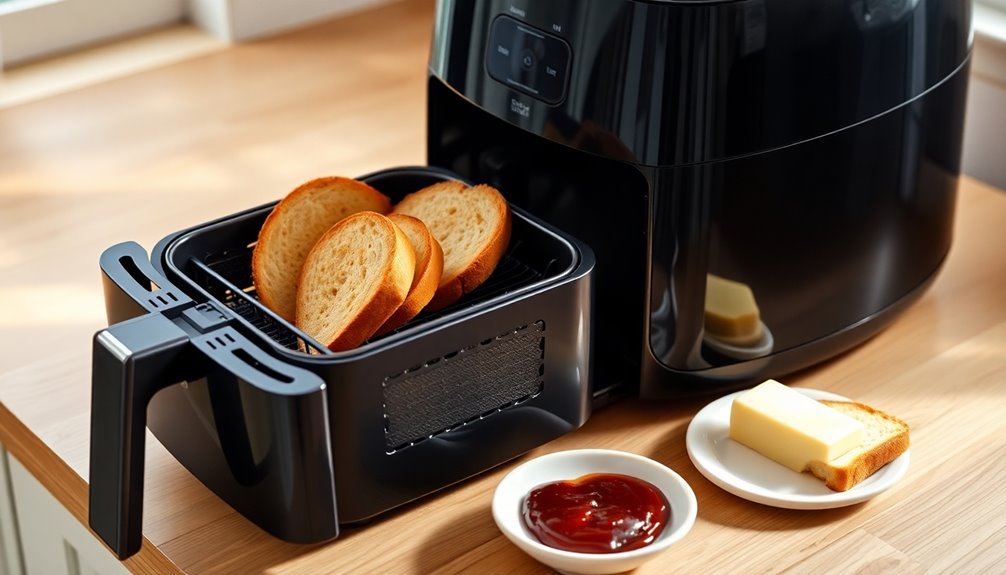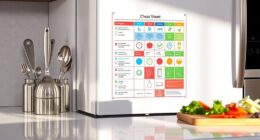You might be surprised, but using aluminum foil in an air fryer isn't straightforward. It can block airflow, leading to uneven cooking and soggy dishes. Plus, loose foil may cause fires by obstructing heating elements. Health-wise, aluminum can leach into your food, raising concerns about toxicity and long-term effects. Manufacturers often caution against foil use. If you still want to use it, secure it properly and avoid covering the basket completely. There are better alternatives, like parchment paper or silicone mats, that can enhance your cooking experience without the risks. Stick around to discover more about safe kitchen practices!
Key Takeaways
- Using aluminum foil in an air fryer can block airflow, leading to uneven cooking and soggy food.
- Foil may pose health risks by leaching aluminum into food, especially at high temperatures.
- Manufacturers generally advise against using aluminum foil due to potential fire hazards and contamination.
- Properly using foil requires weighing it down and ensuring it doesn't cover the mesh basket completely.
- Consider alternatives like parchment paper or silicone mats for safer, more efficient cooking and easier cleanup.
Understanding Aluminum Foil Risks
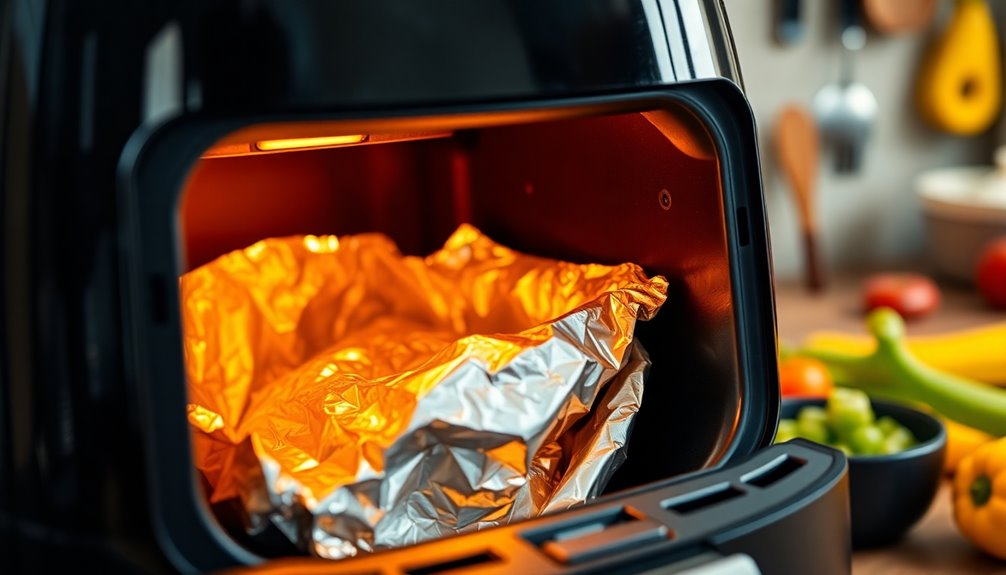
While you might think using aluminum foil in your air fryer is harmless, it actually comes with several risks that could jeopardize both safety and food quality.
For starters, if the aluminum foil gets stuck in the heating elements or blocks the fan, it can lead to fire hazards. Plus, if the foil isn't properly secured, it might fly around during cooking, contaminating your food with tiny particles.
This improper use can also obstruct airflow, essential for even cooking, resulting in poorly cooked meals. Furthermore, there are health concerns about the potential toxicity of aluminum particles entering your food and the long-term effects of aluminum consumption.
Given these safety risks, manufacturers typically advise against using aluminum foil in air fryers.
Safe Ways to Use Foil
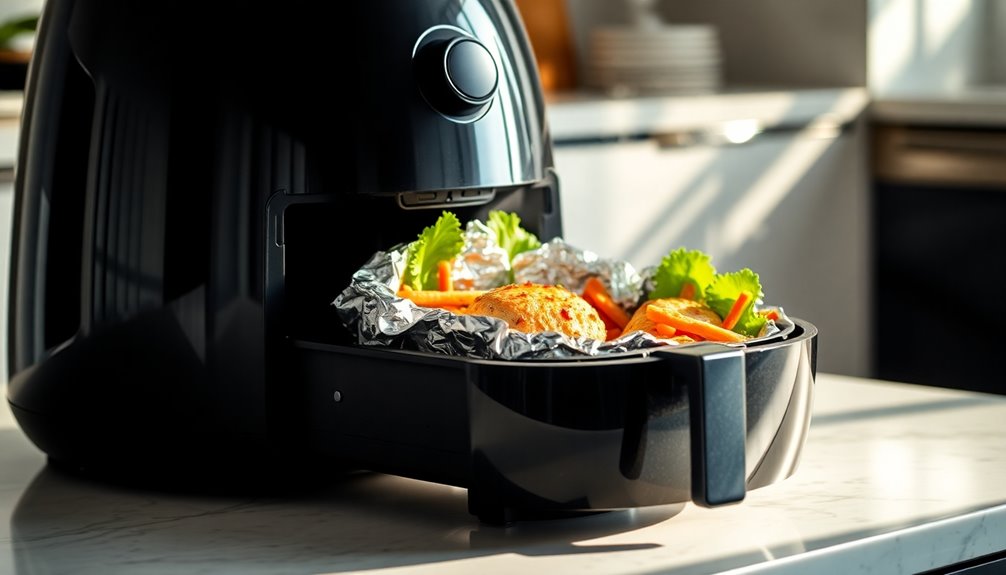
Using aluminum foil in your air fryer can be done safely with a few precautions in mind.
First, make certain to weigh down the foil with heavy ingredients. This prevents it from flying around and blocking airflow, which is essential for even cooking. You can wrap foods like fish and vegetables in foil to create a stable package that retains moisture while still allowing some airflow.
Avoid covering the mesh basket completely, as this disrupts air circulation. If you place foil at the bottom of the pan for easier cleanup, do so judiciously to maintain airflow.
Always make sure the foil is secured in place to avoid uneven cooking results. Following these tips will help you use foil safely in your air fryer.
Effects on Airflow

Using aluminum foil incorrectly in your air fryer can block airflow, which is essential for even cooking.
When the hot air can't circulate properly, you might end up with unevenly cooked food and a less efficient cooking process.
To maintain peak performance, be mindful of how you use foil and avoid covering the mesh basket completely.
Airflow Blockage Risks
When aluminum foil obstructs airflow in an air fryer, it can severely impact cooking efficiency.
Since air fryers rely on hot air circulation, any blockage from foil hinders this flow, leading to unevenly cooked food. For instance, your french fries might end up soggy instead of crispy.
If the foil blocks the fan or heating elements, you risk overheating, which could even cause a fire hazard. Proper airflow is crucial for achieving that desired golden-brown finish on your meals.
Additionally, using foil incorrectly may lead to food particles getting stuck in the mesh basket, complicating cleanup and affecting the air fryer's performance.
Cooking Efficiency Impact
Although aluminum foil can be handy for cooking, improper placement in an air fryer can greatly disrupt cooking efficiency. When you use foil incorrectly, it can block the essential airflow that air fryers rely on. This can lead to uneven cooking and less crispy results.
To guarantee your air fryer operates at peak performance, consider these tips:
- Avoid covering the mesh basket completely with foil.
- Cut the foil to fit the food without obstructing airflow.
- Secure the foil well to prevent it from moving during cooking.
- Use foil sparingly, only when necessary.
Cooking Efficiency Challenges
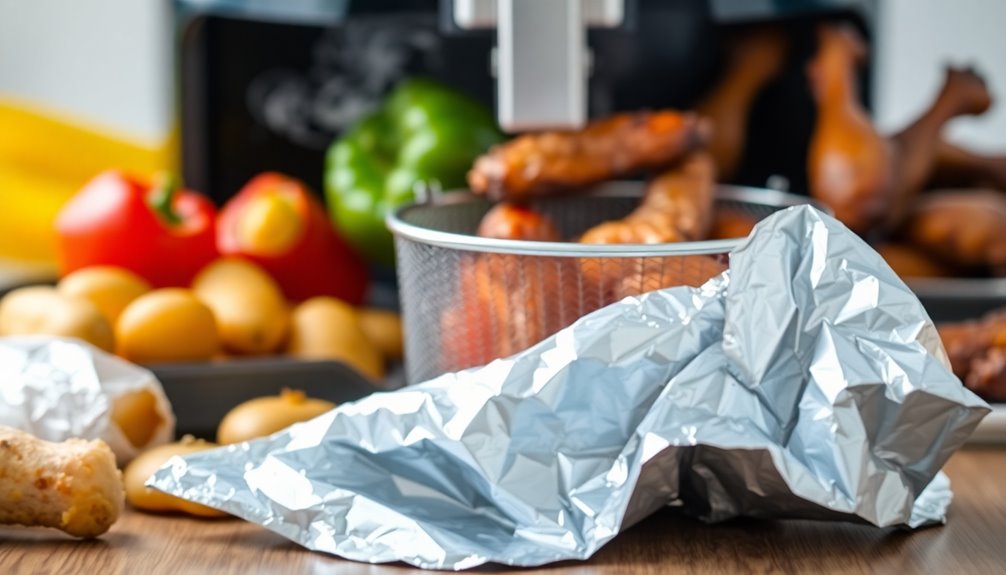
While aluminum foil can be handy in many cooking scenarios, it poses specific challenges in an air fryer that can compromise cooking efficiency.
When you cover the mesh basket completely with foil, you block important airflow. This airflow is crucial for cooking your food evenly, and without it, you might end up with unevenly cooked meals.
The starfish design of most air fryer baskets is specifically crafted to enhance this circulation, but foil disrupts it. As a result, you may notice longer cooking times and the need for extra rotations or adjustments.
To achieve that perfect crispness and texture, it's important to place foil carefully, ensuring it doesn't hinder airflow in your air fryer.
Cleaning With Aluminum Foil

Using aluminum foil in your air fryer can seem like a quick fix for cleanup, but it often complicates the process instead.
Foil mightn't catch all food particles, leading to buildup in the mesh basket. If improperly placed, it can block airflow, causing uneven cooking and harder cleanup.
Instead of relying on foil, consider these alternatives:
- Removable baskets: They're easy to clean and dishwasher safe.
- Parchment paper: It minimizes sticking and can be discarded after use.
- Silicone mats: Reusable and easy to clean, they protect the basket.
- Regular cleaning: Make it a habit to maintain your air fryer's performance without foil complications.
Additionally, regular maintenance of your air fryer, including cleaning removable baskets, helps ensure optimal cooking performance and prolongs the appliance's lifespan.
These options simplify your cleanup routine!
Maintenance Tips for Air Fryers

To keep your air fryer in peak condition, regular maintenance is crucial.
Start by cleaning the mesh basket after each use to prevent food particles from building up, which can affect performance. Use mild detergent and warm water for cleaning, avoiding abrasive materials that could scratch surfaces.
Consider using removable liners or parchment paper instead of foil; this simplifies cleanup while maintaining proper airflow.
Don't forget to wipe down the exterior and interior with a damp cloth to eliminate grease and residue.
Finally, periodically check the heating element and fan for any buildup or blockages. This guarantees peak cooking efficiency and extends the longevity of your appliance, keeping your air fryer running smoothly.
Health Concerns of Aluminum
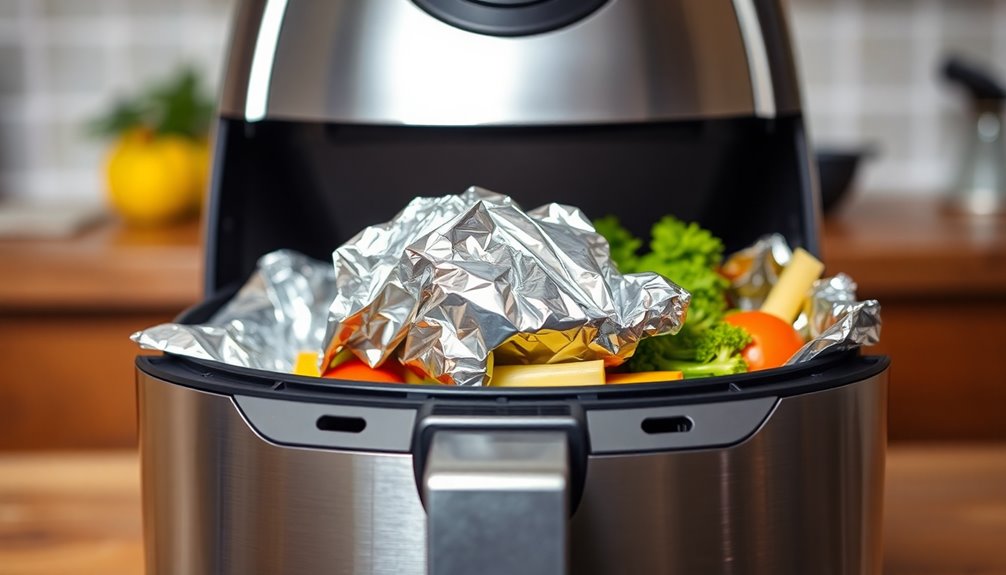
Although aluminum foil is a popular cooking tool, it raises several health concerns that you should consider. Here are some key points:
- Leaching: Aluminum particles can leach into food, especially at high temperatures.
- Kidney Risks: Increased aluminum levels in food could be harmful, particularly for those with kidney issues or who consume it frequently.
- Neurodegenerative Diseases: Some studies link high aluminum intake to conditions like Alzheimer's, though research is ongoing and not definitive.
- Chemical Coatings: Certain foils may have harmful chemical coatings that can release toxins when heated.
To minimize potential health risks, it's wise to limit aluminum foil use in cooking, especially at high heat.
Alternatives to Aluminum Foil
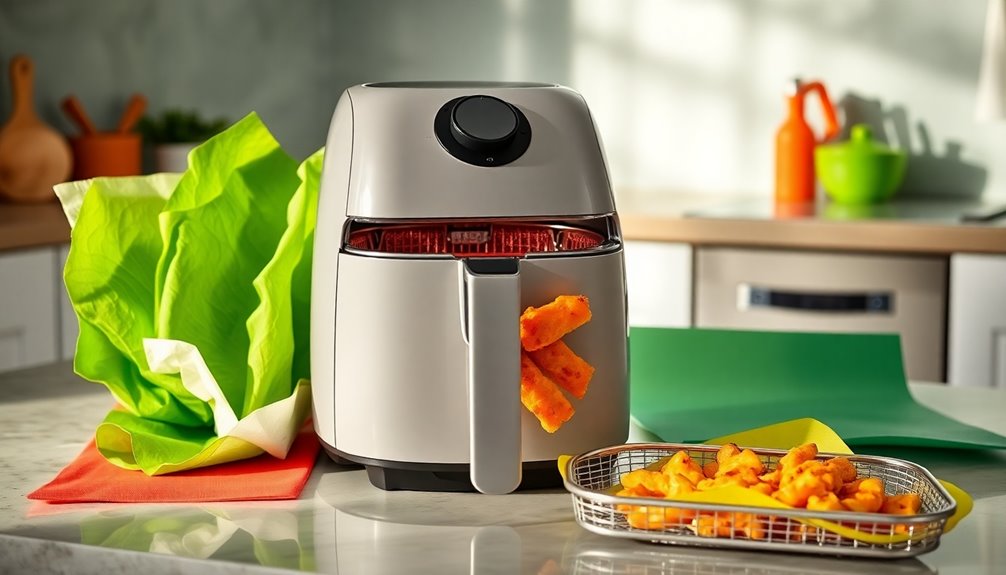
If you're looking for alternatives to aluminum foil in your air fryer, you've got some great options.
Parchment paper and silicone baking mats can make cooking a breeze while keeping your food from sticking.
Plus, reusable cooking bags are another handy choice that can simplify your air frying experience. Additionally, using fire safety equipment is crucial when operating any cooking appliance to ensure a safe environment.
Parchment Paper Options
While aluminum foil is a common cooking choice, parchment paper offers a fantastic alternative for air fryer enthusiasts.
It's heat-resistant and allows for proper airflow, ensuring even cooking results. Plus, it minimizes risks associated with blocking the air fryer's fan, reducing fire hazards.
Here are some benefits of using parchment paper:
- Customizable Size: Cut it to fit your air fryer basket easily.
- Healthy Cooking: Safe for high temperatures (up to 450°F) without leaching harmful substances.
- Non-Stick Surface: Prevents food from sticking, making cooking a breeze.
- Easy Cleanup: Simplifies post-cooking cleanup while maintaining ideal air circulation.
Additionally, using parchment paper can help maintain proper airflow in your air fryer, enhancing cooking efficiency and results.
Switching to parchment paper could enhance your air frying experience!
Silicone Baking Mats
Silicone baking mats serve as an excellent alternative to aluminum foil for air frying, especially for those who want to reduce waste and enhance their cooking experience.
These mats are reusable and can withstand high temperatures, making them a durable choice. You'll love the non-stick surface that prevents food from sticking, eliminating the need for extra oils or sprays.
Silicone mats also allow proper airflow in your air fryer, ensuring even cooking and browning without blocking the heating elements. Plus, they're easy to clean—most are dishwasher safe, simplifying maintenance.
By using silicone mats, you can reduce aluminum contamination in your food, contributing to a healthier cooking practice. Additionally, using energy-efficient appliances, like heat pumps, can further enhance your sustainable cooking efforts.
Try them out and see the difference they make!
Reusable Cooking Bags
As you look for sustainable cooking options, reusable cooking bags stand out as a fantastic alternative to aluminum foil. These bags, made from food-safe silicone or nylon, can withstand high temperatures and guarantee your food cooks evenly without sticking.
Here are some benefits of using reusable cooking bags:
- Eco-Friendly: Reduce waste by reusing bags instead of single-use foil.
- Easy Cleanup: Many bags are dishwasher safe, making post-cooking cleanup a breeze.
- Secure Cooking: Some bags come with a locking mechanism to prevent spills and keep your food safe.
- Healthier Choice: Minimize exposure to potential toxins often associated with aluminum foil.
Switching to reusable cooking bags can enhance your cooking experience while promoting sustainability! Additionally, using tools that ensure high-quality food preparation can further elevate your culinary results.
Expert Recommendations
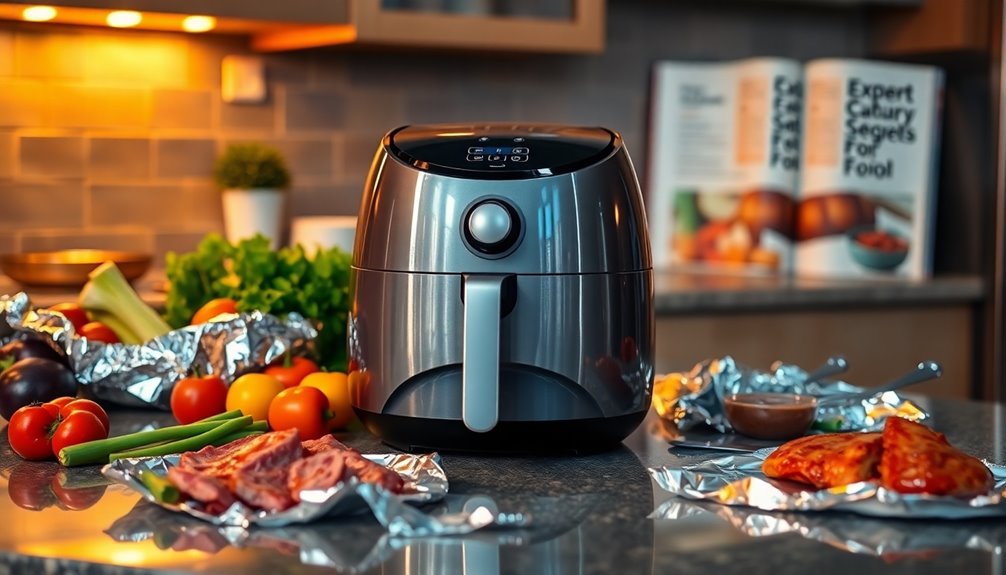
When using aluminum foil in an air fryer, experts recommend caution to guarantee ideal cooking results. They generally advise against its use because it can block airflow, which is vital for even cooking.
If you decide to use foil, make sure it's weighed down with heavy ingredients; otherwise, it could fly around and create a fire hazard. Avoid completely covering the mesh basket, as this hinders the air circulation your air fryer needs.
Regular cleaning is essential, and improper foil use can complicate that process. Additionally, health professionals warn against excessive aluminum foil use due to potential toxicity and ongoing debates regarding long-term health effects.
Final Thoughts on Foil Use
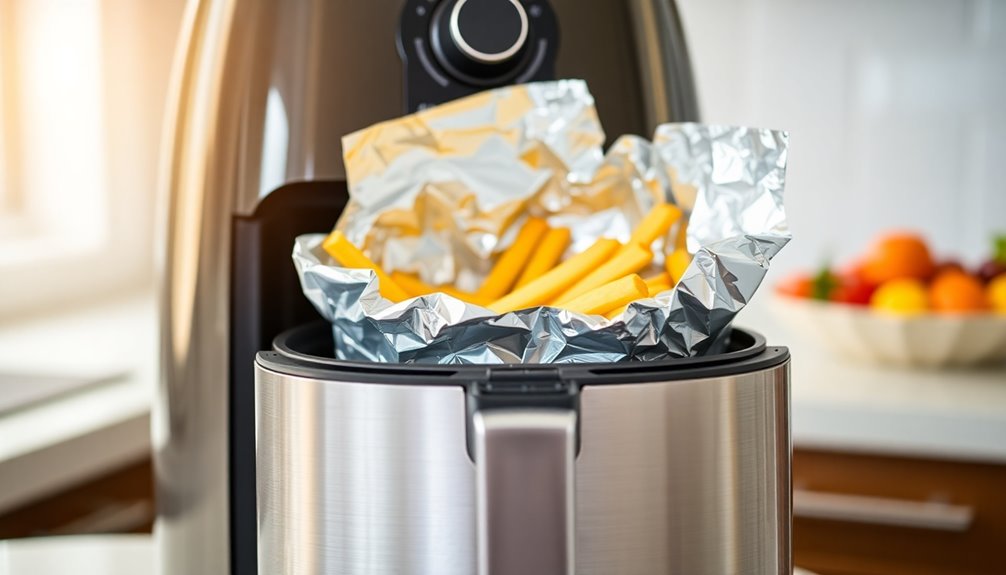
While you might find aluminum foil handy for certain air frying tasks, it's crucial to use it wisely to guarantee safety and best results. Here are some key points to keep in mind:
- Weigh It Down: Always secure the foil with heavy ingredients to prevent it from flying around.
- Airflow Matters: Avoid blocking airflow; it can lead to uneven cooking and disappointing results.
- Manufacturer Warnings: Many manufacturers advise against foil use due to risks like fire hazards and food contamination.
- Cleanup Complications: Using foil improperly can trap food particles, making cleanup a hassle.
Frequently Asked Questions
Why Can't You Use Aluminum Foil in an Air Fryer?
You shouldn't use aluminum foil in an air fryer because it can block airflow, leading to uneven cooking.
If the foil isn't secured, it might fly around and get caught in the heating elements, creating fire hazards.
Manufacturers generally advise against it due to potential contamination from aluminum particles.
While you can use it in specific situations, improper use complicates cleaning and poses health concerns.
Always prioritize your safety and the air fryer's performance.
What Can I Line My Air Fryer Basket With?
What's a kitchen without a little creativity? You can line your air fryer basket with parchment paper, which lets hot air circulate while preventing sticking.
Silicone mats are another great option, offering a reusable, non-stick surface. Just make sure you don't cover the entire basket; airflow is key for even cooking.
And don't forget to check your air fryer's manual for any specific recommendations regarding liners for peak performance!
Is It Better to Put Foil or Parchment Paper in the Air Fryer?
When deciding whether to use foil or parchment paper in your air fryer, parchment paper is generally the better choice.
It promotes better airflow, ensuring your food cooks evenly and gets crispy. Plus, it won't block the air fryer's fan, which is essential for heat circulation.
Parchment paper is often non-stick and simplifies cleanup, unlike foil, which can complicate things if not managed properly.
What Can You Not Put in an Air Fryer?
You shouldn't put certain items in an air fryer if you want to achieve the best results.
Avoid large pieces of foil or parchment paper, as they can block airflow. Foods with wet batters, like pancakes, can create a mess and stick. Whole roasts are too big and can hinder even cooking.
Also, never use plastic containers or utensils; they can melt and release harmful chemicals into your food.
Conclusion
In the kitchen, aluminum foil can be a double-edged sword, much like a trusty knight with a few hidden flaws. While it can protect your food and make cleanup easier, it can also hinder airflow and pose health risks. As you navigate your culinary quests, remember to wield this knight wisely. Explore safe alternatives and heed expert advice, ensuring your cooking adventures are both delightful and safe. After all, a well-informed cook is the true hero of the kitchen!
